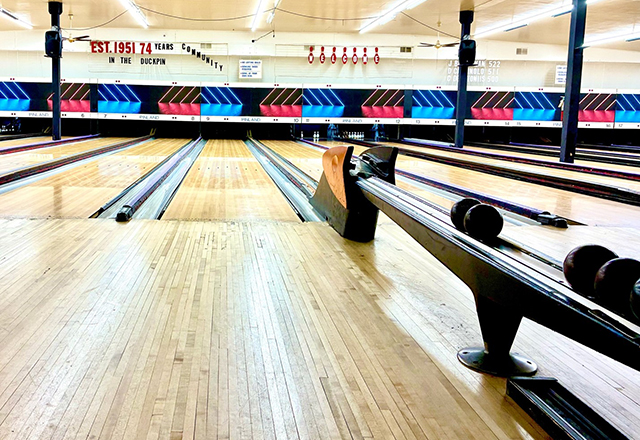Bowling is a leisurely but surprisingly old sport that may date back as early as ancient Egypt. Many different versions have existed throughout history, but modern bowling in its most common form is more precisely named tenpin bowling. In tenpin bowling, a large ball (about 8.5 inches in diameter and 10–16 pounds in weight) is thrown at 10 pins that each stand 15 inches tall. Although tenpin is what most of us think of when we hear “bowling,” here in Baltimore there is a unique version of bowling that many throughout the country are not even aware of.
Growing up on the west coast, I didn’t know variations of bowling existed. After starting my postdoc at Hopkins, I went bowling with a group one night at Mustang Alley’s near Little Italy. After finding out the tenpin bowling lanes were filled for the night, we decided to take the only lane they had available, which was what they called a “duckpin” lane. The duckpin lane looked like a tenpin lane, but had much smaller balls (about 5 inches in diameter and 4 pounds), shorter pins (standing at 9 inches tall), and gave bowlers three balls per frame instead of two. After only a few frames of trying to knock down the much smaller pins with a ball that fit in my palm, I was hooked.
Duckpin bowling has been around since at least 1900. Although its history is still disputed, it is thought to have been invented by Baltimore Orioles players John McGraw and Wilbert Robinson. Bored of normal tenpin bowling in their saloon on North Howard Street, they decided to spice it up with modified pins cut down in size. Legend claims that the name came from Wilbert, who thought the small white pins, which explosively fly around after being hit, looked like ducks. Throughout Baltimore and the mid-Atlantic, the game took off quickly. Although much more challenging compared to tenpin bowling (a perfect 300 score game in duckpin has never happened), duckpin alleys in Maryland were the norm for most of the 20th century. But why have most of us who didn’t grow up here never heard of it?
Although there may be many reasons, one substantial one comes from an inventor who declined to give into big business. In 1953, Ken Sherman created the world’s first automatic pinsetter for duckpin bowling. However, when offered by bowling giant Brunswick to buy his patent, Ken refused and lost the resources to mass manufacture and install his duckpin pinsetters across the country, destining duckpins for regional obscurity.
Sadly, duckpin bowling is becoming even more obscure today. The number of alleys that offer it has shrunk to under 40 from over 450 in 1963. Lucky for those of us at Hopkins, many of these alleys are in the Greater Baltimore area, where groups of dedicated people keep the duckpin tradition alive. I encourage you to try this challenging but addicting version of bowling. Because the balls are smaller and lighter, duckpin bowling is something the whole family can enjoy, even young kids. If you enjoy it, join a league where you can hone your skills and make friends with people from all walks of life. Hopefully, by patronizing the few remaining duckpin alleys, this unique mid-Atlantic pastime can live on.
A list of Baltimore area alleys that offer duckpin bowling:
- Mustang Alley’s, 1300 Bank St. #2 Baltimore, MD 21231
- Pinland, 10 N Dundalk Ave. Baltimore, MD 21222
- AMF Southwest, 4991 Fairview Ave. Linthicum Heights, MD 21090
- Parkville Bowling Lanes, 7607 Harford Rd. Baltimore, MD 21234
- Stoneleigh Lanes, 6703 York Rd. Baltimore, MD 21212
- AMF Dundalk, 1101 Merritt Blvd. Dundalk, MD 21222
- AMF Towson, 701 Southwick Dr. Towson, MD 21286
- Severna Park Lanes, 840 Ritchie Hwy. Severna Park, MD 21146
Related Content
- Scenic Fall Sights in Maryland
- A New Student’s Guide to Baltimore Cafes
- Pumpkin Spice and Sweater Weather: Fall Is Almost Here in Baltimore!
Want to read more from the Johns Hopkins School of Medicine? Subscribe to the Biomedical Odyssey blog and receive new posts directly in your inbox.
